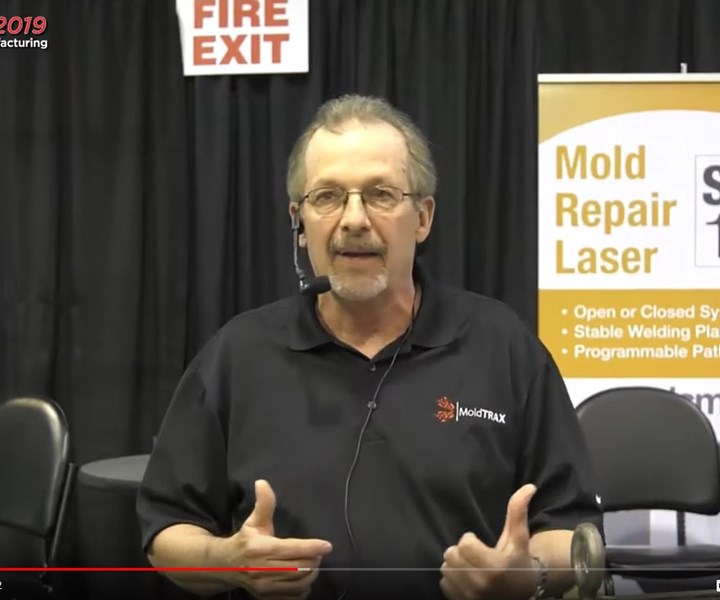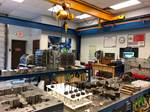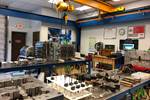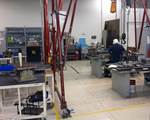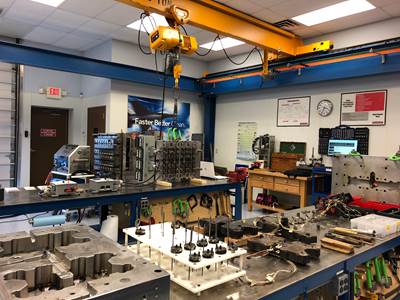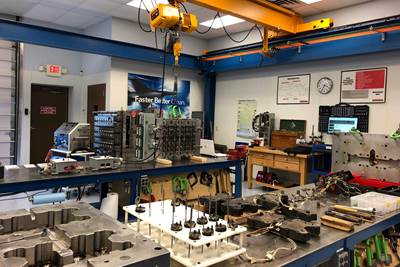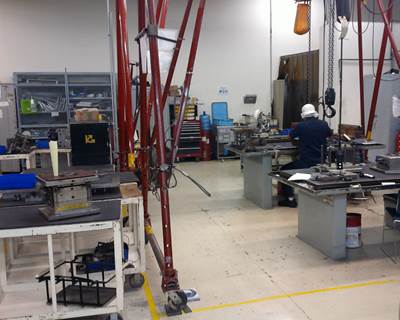Tool Shop Live Transcript
Steve Johnson, President of Mold Trax.
Welcome to Tool Shop Live a unique exhibit focused on tool rooms and the type of equipment required and how it should be laid out? We're going to cover some topics about what it takes to have a state-of-the-art tool room for today's maintenance world.
We're going to start off a little bit by talking about tool room layouts. Some of the things that we need, we're going to show you some examples of some tool rooms, who have completely revamped their shops, spent very few dollars, but put a lot of thought into the flow, into the layout and into things people don't think about like lighting, utilities, bench ergonomics, how much room we need between the benches, depending upon what type of tools that we're working on.
We conduct MCAs (maintenance capability assessments) at Mold Trax. We actually come into your tool room and we look at all things maintenance-related. We start at the press to see what type of documentation you're collecting. Then we work our way into the tool room, looking at your facilities, how your shop is designed and whether it is conducive to the type of molds coming into your tool room.
Here are some of the top maintenance issues we've observed.
- Most toolrooms are just too small. They're overcrowded. There's sharing this space with other machinery or maybe plant maintenance and benches are crowded, jammed into the side Bridgeports and other metalworking equipment.
- Poor lighting. We always recommend that a toolroom should not have anything less than 75. This is important when you're working on tools, plates are standing up and you're trying to see in the counterbores and sharp edges. You don't want to have to pull out a Maglite every time you want to do a take a look at the back of a plate and see what type of corrosion you have
- Incorrect bench. A ToolingDocs bench has everything that you need. Now, this particular style of bench is designed for a 6,000-pound mold or less. We're all about ergonomics; the job of a repair technician is 50% hand skills, 50% gray matter. So we have to be able to control the work that we're doing on our molds. To be able to do that efficiently, we have to have things at the right height, we have to have benches at the right length, so we can completely disassemble and work through the eight stages correctly. So bench design is critical.
- No access to utilities. You must have access to the proper utilities. This bench comes completely equipped with all the air and power; a manifold water system, and a Burger Brown manifold system on the end of the bench. We can do complete testing: GPM tests and flow restriction analysis.
- Lack of data. A lot of shops only have one PC location, one maintenance spot. So you've got four or five or six guys or even more in a tool room, and they don't use data on a daily basis. Management doesn't always appreciate how vital that is to our jobs. So they stick a little monitor out on a bench somewhere over in the corner of the shop. If you want trades people to give you usable, accurate data, it has to be easy for them. So we recommend a dock station. We don't sell these but will tell you where you can get the pieces and parts. We have a battery backup printer, keyboard and a nice 24-inch monitor. You can roll this thing right up to a bench and now becomes another tool that I can use. It's not stuffed over in a corner.
- Poor housekeeping practices. We have a lot of junk lying around like obsolete tooling. We have “limbo cabinets of tooling” that we're not sure what we want to do with. So we just stick it in the cabinet and wait for an emergency to pull it back out, reinspect it and go through this whole thing again. So we have beat-up cabinets full of miscellaneous junk fittings. It doesn't take a lot of capital investment to even have poorly outfitted shops at least clean and organized so we can work safer.
- No vacuum system. One of the things that we incorporated when I was to manager at Abbott Labs was we put in a nice vacuum unit. So because we worked on a lot of hot runner tools. And so part of the practice of working on hot runner manifolds, many times we’ll have to heat these things up. This is a 30-by-50 booth. This is a perfect size booth for a four-bench operation. And if I had an appropriate vacuum system I would be able to reach all four benches and evacuate any kind of smoke that comes off of a hot runner system that I don't want my employees smelling.
- No standard bench design. Benches need to be designed specific to the type of mold that you're working on. When you make your living behind here all day, a couple of inches up or down, can really put a strain on your back and make a huge difference on your ability to control the operation that you're performing.
- No posted metrics. Every tool shop needs to have goals: defect reduction, unscheduled mold stop reduction. What modes are costing me the most in tooling and labor to get through 100,000 cycle runs? This is the kind of data that we want to be able to collect. We want to set targets and goals. We want to post these in the tool room, so maintenance becomes more than just firefighting and fixing the issue of the day. We have to have viable targets and goals so we have something to work for. These are the things that we see when we do maintenance audits or around the country.
So What Do We Need?
Cleaning equipment, an ultrasonic tank. Over time we see that 75% of the time that you're working on a mold, you're going to be cleaning something; I can guarantee that. I've looked at enough data analysis enough companies to know 75% of the time that you're working on a mold or repairing some type of issue, it involves cleaning that component or these plates. I paid for my ultrasonic for 30 days. It's imperative that we have one of those.
The same with dry ice, which is not an abrasive method. It does a great job in its specialties and that is blowing the resin off cleaning off resin residue off of hot tooling. For those of you who run LSR tools, liquid silicone rubber, or other thermal sets, you want to be able to use dry ice.
That's the best way to cleanse, especially some of these larger tools where you want to clean off the faces. I bought one so I could use it out on the floor. Instead of scotch brightening the face of mold when I'm doing my in-mold press PMs. We simply rolled the dry ice machine out. We went from a from a 45-minute scotch bright wipe down, trying to get all the residue out, to a 10 minute blow off with the dry ice machine. Also, a very quick ROI.
Plastic media. Most people have sand blasters with some type of glass beads, aluminum oxide, something extremely abrasive. Plastic media is available from a company called Polyblast. You can buy different hardnesses and diameters. It'll remove heavy residue, like rust, off of mld componentry, and it won't remove your plating. It won’t dull the chrome. So, look into plastic media blasting.
Lighting. We mentioned lighting. [We recommend] 75-foot candles, minimum. This room is 50. It needs to be twice this bright.
Benches. We need to have the correct spacing so that it's safe. At our four bench shop we have five feet in between all of our benches. This gives me plenty of room to get my roll around through these benches. If I'm working on unscrewing tools with long racks, again, I can lay them down; I got plenty of room to get around these benches. All these things are critical when you're working on molds on a daily basis.
Overhead hoist system. Unbelievable how many companies are picking up molds with fork trucks and trying to set them on a bench and then slide the forks back and forth to get molds open. I can cover this entire area for about $40,000 with a nice overhead hoist system with not one, but two movable trucks. One of the big problems with bridge cranes is that it's always tied up. And when I need to use it, it's got something hanging or somebody else has this thing.
Floors and walls. Everybody loves Stonehard. I'm anti-Stonehard in a tool room. Stonehard is basically just an epoxy over some sand. It looks good for a day. Then as soon as we start moving molds around, we start dropping molds start scratching things up, the floor goes to crap. You cannot patch it. It'll never look good again. You can see every scratch and ding that was ever put on it.
Also, they call it stone hard for a reason. If I'm working on this tool, and I have something roll off the bench [such as] an ejector pen or a core with a sharp edge, it hits that Stonehard I'm going to ding that piece of tooling.
We prefer manufacturing grade tile. It looks fantastic and wears well. You can polish it up and you can replace the tiles. Plus, if a piece of tooling rolls off and hits that tile it's not going to do a thing to it.
Mold splitter. A Die Sep mold splitter is a fantastic tool for basically any size of tool. I’m used to doing things by hand on 6,000-pound mold or less, but I was never able to operate a Die Sep. If you got some space in your shop, that's the fastest, safest way to open up a mold and flip it over on its back and get quick access to it.
Mold polishing equipment. At our shop, we have eight of Gesswein polishers; two for every bench. We want our repair technicians to have some basic hand skills, such as how to remove a burr, do some light polishing, refurb an edge with a laser welder. These skills don’t take 40 years-worth of experience to master. It takes the right equipment, a little bit of training, and you're well on your way to saving literally hundreds of thousands of dollars a year, not including all the time.
Fast heat checkers. On a day-to-day basis, if I'm checking molds, I want to make sure that my heaters, my controllers, and that everything's up to speed. I'm going to grab one of these fast checkers, and what normally might take me 10–15 minutes to do with an Ohm-meter, I'm going to do in less than a minute. These things are well worth the money. They're foolproof and going to help you reduce mistakes.
I spent 24 years as a tool maker behind the bench, and I know how important accommodations such as a shelf a foot off the ground or gel mats to stand on are. State-of-the-art shops don’t spend a ton of money. It's about utilizing the space that you have. Cleaning out that old junk, getting better lighting. When you go back, take a look at your old shops give us a call.
